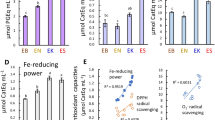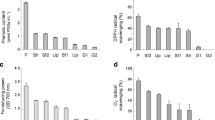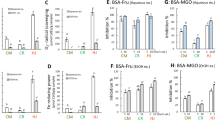Abstract
Outbreaks of algal blooms for Sargassum horneri and Ulva spp., called golden and green tides on the South Korean coast, severely damage the local coastal environment and marine ecological system. However, these edible algae are natural resources of beneficial bioactive components, such as dietary fibres, phenolic compounds, and minerals. In this study, the antioxidant and anti-glycation properties of 2% aqueous extract solution (AES) in vitro from S. horneri (Sh) and Ulva pertusa (Up), and the effects of dried S. horneri and Up on the caecal microbiota of mice fed a high-sucrose and low-fiber diet were investigated. Total phenolic content, antioxidant activity (DPPH radical scavenging and Fe-reducing power), and anti-glycation activity in the BSA-fructose model were higher in Sh-AES than in Up-AES groups. Male Institute of Cancer Research (ICR) mice fed a 5% (w/w) S. horneri diet for 14 days showed a reduced increase in body weight. 16S rDNA (V4) amplicon sequencing results showed that the ratio of Firmicutes/Bacteroidota was reduced after S. horneri and U. pertusa intake. Faecalibaculum rodentium-, Akkermansia muciniphila-, and Roseburia intestinalis-like bacteria were enriched in the S. horneri group. Phocaeicola vulgatus-like bacteria were abundant in both the S. horneri and U. pertusa groups. In contrast, the prevalence of Clostridium disporicum-like bacteria was low in mice fed the S. horneri diet. Among the bacteria enriched after S. horneri and U. pertusa administration, P. vulgatus was found to be prevalent. From these results, S. horneri from golden tides may be useful as a functional food.





modified by LEfSe (p < 0.01) for caecal microbiota in mice fed a high sucrose-containing diet with no fibre (n = 5) and 5% (w/w) Sargassum horneri (n = 5)
Similar content being viewed by others
Data availability
The datasets generated during and/or analysed during the current study are available from the corresponding author on reasonable request.
References
Amorati A, Valgimigli L (2018) Methods to measure the antioxidant activity of phytochemicals and plant extracts. J Agric Food Chem 66:3324–3329
AOAC Intl (2006) Official methods of analysis, 18th ed. Association of Official Analytical Chemists (AOAC). Washington, DC
Chi C, Xue Y, Liu R, Wang Y, Lv N, Zeng H, Buys N, Zhu B, Sun J, Yin C et al (2020) Effects of a formula with a probiotic Bifidobacterium lactis supplement on the gut microbiota of low birth weight infants. Eur J Nutr 59:1493–1503
Duwaerts CC, Maher JJ (2019) Macronutrients and the adipose-liver axis in obesity and fatty liver. Cell Mol Gastroenterol Hepatol 7:749–761
Eda M, Kuda T, Kataoka M, Takahashi H, Kimura B (2016) Anti-glycation properties of the aqueous extract solutions of dried algae products harvested and made in the Miura Peninsula, Japan, and effect of lactic acid fermentation on the properties. J Appl Phycol 28:3617–3624
Fernando IPS, Jayawardena TU, Sanjeewa KKA, Wang L, Jeon YJ, Lee WW (2018) Anti-inflammatory potential of alginic acid from Sargassum horneri against urban aerosol-induced inflammatory responses in keratinocytes and macrophages. Ecotoxicol Environ Saf 160:24–31
Guo L, Goff HD, Xu F, Liu F, Ma J, Chen M, Zhong F (2020) The effect of sodium alginate on nutrient digestion and metabolic responses during both in vitro and in vivo digestion process. Food Hydrocolloids 107:105304
Harada M, Kuda T, Nakamura S, Lee GY, Hajime T, Kimura B (2021) In vitro antioxidant and immunomodulation capacities of low-molecular weight-alginate- and laminaran-responsible gut indigenous bacteria. LWT Food Sci Technol 151:112127
Hirota K, Inagaki S, Hamada R, Ishihara K, Miyake Y (2014) Evaluation of a rapid oral bacteria quantification system using dielectrophoresis and the impedance measurement. Biocontrol Sci 19:45–49
Jesumani V, Du H, Pei O, Zheng C, Cheong KL, Huang N (2019) Unravelling property of polysaccharides from Sargassum sp. as an anti-wrinkle and skin whitening property. Int J Biol Macromol 140:216–224
Kasubuchi M, Hasegawa S, Hiramatsu T, Ichimura A, Kimura I (2015) Dietary gut microbial metabolites, short-chain fatty acids, and host metabolic regulation. Nutrients 7:2839–2849
Kim HS, Sanjeewa KKA, Fernando IPS, Ryu BM, Yang HW, Ahn G, Kang MC, Heo SJ, Je JG, Jeon YJ (2018) A comparative study of Sargassum horneri Korea and China strains collected along the coast of Jeju island South Korea: Its components and bioactive properties. Algae 33:341–349
Kim BR, Shin J, Guevarra RB, Lee JH, Kim DW, Seol JH, Lee JH, Kim HB, Isaacson R (2017) Deciphering diversity indices for a better understanding of microbial communities. J Microbiol Biotechnol 27:2089–2093
Knapp BK, Bauer LL, Swanson KS, Swanson KS, Tappenden KA, Fahey JRGC, Godoy MRC (2013) Soluble fiber dextrin and soluble corn fiber supplementation modify indices of health in cecum and colon of Sprague-Dawley rats. Nutrients 5:396–410
Kong C, Gao R, Yan X, Huang L, Qin H (2019) Probiotics improve gut microbiota dysbiosis in obese mice fed a high-fat or high-sucrose diet. Nutrition 60:175–184
Kuda T, Nishizawa M, Toshima D, Matsushima K, Yoshida S, Takahashi H, Kimura B, Yamagishi T (2021) Antioxidant and anti-norovirus properties of aqueous acetic acid macromolecular extracts of edible brown macroalgae. LWT Food Sci Technol 141:110942
Kuda T, Taniguchi E, Nishizawa M, Araki Y (2002) Fate of water-soluble polysaccharides in dried Chorda filum a brown alga during water washing. J Food Compos Anal 15:3–9
Laurens LML, Wolfrum EJ (2011) Feasibility of spectroscopic characterization of algal lipids: Chemometric correlation of NIR and FTIR spectra with exogenous lipids in algal biomass. Bioenergy Res 4:22–35
Lv L, Cheng Y, Zheng T, Li X, Zhai R (2014) Purification, antioxidant activity and antiglycation of polysaccharides from Polygonum multiflorum Thunb. Carbohyd Polym 99:765–773
Mohammed A, Bissoon R, Bajnath E, Mohammaed K, Lee T, Bissram M, John N, Kjalsa N, Lee KY, Ward K (2018) Multistage extraction and purification of waste Sargassum natans to produce sodium alginate: An optimization approach. Carbohyd Polym 198:109–118
Morrison DJ, Preston T (2016) Formation of short chain fatty acids by the gut microbiota and their impact on human metabolism. Gut Microbes 7:189–200
Mizutani K, Ikeda K, Yamori Y (2000) Resveratrol inhibits AGEs-induced proliferation and collagen synthesis activity in vascular smooth muscle cells from stroke-prone spontaneously hypertensive rats. Biochem Biophys Res Commun 274:61–67
Murakami K, Yamaguchi Y, Noda K, Fujii T, Shinohara N, Ushirokawa T et al (2011) Seasonal variation in the chemical composition of a marine brown alga, Sargassum horneri (Turner) C. Agardh. J Food Compos Anal 24:231–236
Nunes N, Rosa GP, Ferraz S, Barreto MC, Pinheiro de Carvalho MAA (2019) Fatty acid composition, TLC screening, ATR-FTIR analysis, anti-cholinesterase activity, and in vitro cytotoxicity to A549 tumor cell line of extracts of 3 macroalgae collected in Madeira. J Appl Phycol 32:759–771
Ottman N, Geerlings SY, Aalvink S, Vos WM, Belzer C et al (2017) Action and function of Akkermansia muciniphila in microbiome ecology, health and disease. Best Pract Res Clin Gastroenterol 31:637–642
Park JJ, Lee WY (2021) Anti-glycation effect of Ecklonia cava polysaccharides extracted by combined ultrasound and enzyme-assisted extraction. Int J Biol Macromol 180:684–691
Peasura N, Laohakunjit N, Kerdchoechuen O, Wanlapa S (2015) Characteristics and antioxidant of Ulva intestinalis sulphated polysaccharides extracted with different solvents. Int J Biol Macromol 81:912–919
Pizzino G, Irrera N, Cucinotta M, Pallio G, Mannino F, Arcoraci V et al (2017) Oxidative stress: Harms and benefits for human health. Oxid Med Cell Longev 2017:841676313
Poncheewin W, Hermes GDA, van Dam JCJ, Koehorst JJ, Smidt H, Schaap PJ (2020) NG-Tax 2.0: A Semantic framework for high-throughput amplicon analysis. Front Genet 10:1366
Quigley EMM (2013) Gut bacteria in health and disease. Gastroenterol Hepatol 9:560–569
Sanjeewa KKA, Jayawardena TU, Kim SY, Lee HG, Je JG, Jee Y, Jeon YJ (2020) Sargassum horneri (Turner) inhibit urban particulate matter-induced inflammation in MH-S lung macrophages via blocking TLRs mediated NF-κB and MAPK activation. J Ethnopharmacol 249:112363
Schalkwijk CG, Stehouwer CDA, van Hinsbergh VWM (2004) Fructose-mediated non-enzymatic glycation: sweet coupling or bad modification. Diabetes Metab Res Rev 20:369–382
Seong H, Bae JH, Seo JS, Seo JS, Kim SA, Kim TJ, Han NS (2019) Comparative analysis of prebiotic effects of seaweed polysaccharides laminaran, porphyran, and ulvan using in vitro human fecal fermentation. J Funct Foods 57:408–416
Shahidi F, Ambigaipalan P (2015) Phenolics and polyphenolics in foods, beverages and spices: Antioxidant activity and health effects – A review. J Funct Foods 18:820–897
Shao P, Chen X, Sun P (2013) In vitro antioxidant and antitumor activities of different sulfated polysaccharides isolated from three algae. Int J Biol Macromol 62:155–161
Shao P, Chen X, Sun P, Sun P (2014) Chemical characterization, antioxidant and antitumor activity of sulfated polysaccharide from Sargassum horneri. Carbohyd Polym 105:260–269
Shen Z, Zhu C, Quan Y, Yang J, Yuan W, Yang Z, Wu S, Luo W, Tan B, Wang X (2018) Insights into Roseburia intestinalis which alleviates experimental colitis pathology by inducing anti-inflammatory responses. J Gastroenterol Hepatol 33:1751–1760
Sinclair L, Osman OA, Bertilsson S, Eiler A (2015) Microbial community composition and diversity via 16S rRNA gene amplicons: Evaluating the illumina platform. PLoS ONE 10:e0116955
Smetacek V, Zingone A (2013) Green and golden seaweed tides on the rise. Nature 504:84–88
Song W, Wang Z, Zhang X, Li Y (2018) Ethanol extract from Ulva prolifera prevents high-fat diet-induced insulin resistance, oxidative stress, and inflammation response in mice. Biomed Res Int 9:1374565
Sonnenburg ED, Smits SA, Tikhonov M, Higginbottom SH, Wingreen NS, Sonnenburg JL (2016) Diet-induced extinctions in the gut microbiota compound over generations. Nature 529:212–215
Takei M, Kuda T, Eda M, Shikano A, Takahashi H, Kimura B (2017) Antioxidant and fermentation properties of aqueous solutions of dried algal products from the Boso Peninsula, Japan. Food Biosci 19:85–91
Takei M, Kuda T, Fukunaga M, Toyama A, Goto M, Takahashi H et al (2019) Effects of edible algae on caecal microbiomes of ICR mice fed a high-sucrose and low–dietary fibre diet. JAppl Phycol 31:3696–3978
Takei MN, Kuda T, Taniguchi M, Nakamura S, Takahashi T, Kimura B (2020) Detection and isolation of low molecular weight alginate- and laminaransusceptible gut indigenous bacteria from ICR mice. Carbohyd Polymers 238:116205
Tako M, Tamanaha M, Tamashiro Y, Uechi S (2015) Structure of ulvan isolated from the edible green seaweed, Ulva pertusa. Adv Biosci Biotechnol 6:60824
Taniguchi M, Kuda T, Takei M, Takahashi H, Kimura B (2021) Effects of fermented Aphanizomenon flos-aquae on the caecal microbiome of mice fed a high-sucrose and low-dietary fibre diet. J Appl Phycol 33:397–407
van Tussenbroek BI, Hernández AHA, Rodríguez-Martínez RE, Julio Espinoza-Avalosb HM, Canizales-Floresa CE, González-Godoy CE (2017) Severe impacts of brown tides caused by Sargassum spp. on near-shore Caribbean seagrass communities. Mar Pollut Bull 122:272–281
Vlassara H (2005) Advanced glycation in health and disease: Role of the modern environment. Ann N Y Acad Sci 1043:452–460
Wang W, Yagiz Y, Buran TJ, Nunes CdN, Gu L (2011) Phytochemicals from berries and grapes inhibited the formation of advanced glycation end-products by scavenging reactive carbonyls. Food Res Int 44:2666–2673
Wei Q, Liu T, Sun DW, Sun DS (2018) Advanced glycation end-products (AGEs) in foods and their detecting techniques and methods: A review. Trends Food Sci Technol 82:32–45
Wu TR, Lin CS, Chang CJ, Lin TL, Martel J, Ko YF, Ojcius DM, Lu CC, Young JD, Lai HC (2019) Gut commensal Parabacteroides goldsteinii plays a predominant role in the anti-obesity effects of polysaccharides isolated from Hirsutella sinensis. Gut 68:248–262
Yan SF, Ramasamy R, Naka Y, Schmidt AM (2003) Glycation, inflammation, and RAGE: a scaffold for the macrovascular complications of diabetes and beyond. Circulation Res 93:1159–11
Yang JY, Lee YS, Kim Y, Lee SH, Ryu S, Fukuda S, et al. (2017) Gut commensal Bacteroides acidifaciens prevents obesity and improves insulin sensitivity in mice. Mucosal Immunol 10:104–116
Yang W, Cong Y (2021) Gut microbiota-derived metabolites in the regulation of host immune responses and immune-related inflammatory diseases. Cell Mol Immunol 18:866–877
Zhao L, Zhu X, Yu Y, He L, Li Y, Liu R (2021) Comprehensive analysis of the anti-glycation effect of peanut skin extract. Food Chem 362:130169
Zhang Z, Wang F, Wang X, Liu X, Hou Y, Zhang Q (2010) Extraction of the polysaccharides from five algae and their potential antioxidant activity in vitro. Carbohyd Polym 82:118–121
Zheng LX, Chen XQ, Cheong KL (2020) Current trends in marine algae polysaccharides: The digestive tract, microbial catabolism, and prebiotic potential. Int J Biol Macromol 151:344–354
Zou Y, Xue W, Luo G, Deong Z, Qin P, Guo R et al (2019) 1,520 reference genomes from cultivated human gut bacteria enable functional microbiome analyses. Nat Biotechnol 37:179–185
Acknowledgements
This work was partially supported by the Yanmar Resource Recycling Support Organization, Tokyo, Japan and the Toyo Suisan Foundation, Tokyo, Japan. The authors thank Editage (www.editage.com) for their assistance with English language editing.
Author information
Authors and Affiliations
Contributions
Gayang Lee: conceptualisation, methodology, validation, formal analysis, investigation, resources, data curation, writing – original draft, visualisation. Yuko Midorikawa: conceptualisation, methodology, validation, formal analysis, investigation. Takashi Kuda: Conceptualisation, methodology, validation, formal analysis, resources, data curation, writing – review and editing, visualisation, supervision, project administration. Mika Harada and Sae Fujita: formal analysis and investigation. Hajime Takahashi: Conceptualisation, Methodology, Supervision. Bon Kimura: Conceptualisation and supervision.
Corresponding author
Ethics declarations
Competing interest
The authors declare that they have no known competing financial interests or personal relationships that could have influenced the work reported in this paper.
Additional information
Publisher's note
Springer Nature remains neutral with regard to jurisdictional claims in published maps and institutional affiliations.
Supplementary Information
Below is the link to the electronic supplementary material.
Rights and permissions
About this article
Cite this article
Lee, G., Midorikawa, Y., Kuda, T. et al. In vitro antioxidant and anti-glycation properties of Sargassum horneri from golden tides on the South Korean coast and the effect on gut microbiota of mice fed a high-sucrose and low-fibre diet. J Appl Phycol 34, 2211–2222 (2022). https://doi.org/10.1007/s10811-022-02756-5
Received:
Revised:
Accepted:
Published:
Issue Date:
DOI: https://doi.org/10.1007/s10811-022-02756-5




